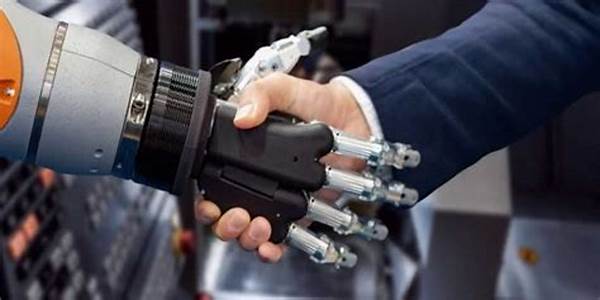Human-computer interaction (HCI) has become a pivotal area of research and development in the age of digital transformation. It encompasses the design and use of computer technology, focusing on the interfaces between people and computers. The field has witnessed remarkable progress in recent years, leading to significant improvements in the way humans engage with digital systems. These advancements are instrumental in enhancing user experience, making technology more accessible, efficient, and intuitive, thereby transforming how individuals and organizations interact with digital resources.
Read Now : Advanced Smart Contract Platforms
Emerging Trends in Human-Computer Interaction
In recent decades, human-computer interaction advancements have shifted from traditional input methods to more intuitive and personalized experiences. The integration of artificial intelligence has played a vital role in understanding user behavior and preferences, enabling systems to offer customized recommendations and interactions. Augmented and virtual reality technologies have opened new dimensions in interactive experiences, allowing users to immerse themselves in virtual environments that feel closer to reality. These emerging technologies highlight the ongoing evolution in HCI, driven by the goal of creating seamless and efficient human-machine interactions.
Furthermore, voice recognition systems demonstrate remarkable accuracy and responsiveness, enabling hands-free operation of devices. Natural language processing (NLP) allows computers to understand and generate human language, enhancing communication between humans and machines. Touchless interfaces, powered by gesture recognition technology, are gaining popularity, reducing the dependency on physical touch for command execution. Collectively, these human-computer interaction advancements aim to maximize user comfort and accessibility, fundamentally redefining the boundaries of digital interaction.
Key Aspects of Human-Computer Interaction Advancements
1. Artificial Intelligence Integration: The incorporation of AI technologies in HCI has led to systems that better understand and predict user needs, fostering more personalized and intelligent interactions.
2. Augmented and Virtual Reality: These technologies bridge the gap between digital and physical realities, offering immersive experiences that transform educational, professional, and entertainment landscapes.
3. Voice and Speech Recognition: Enhanced voice interfaces facilitate efficient hands-free interaction, improving accessibility for users with varied needs and preferences.
4. Gesture Recognition: This advancement allows users to interact with devices through intuitive gestures, enhancing the user experience by reducing reliance on physical contact.
5. Natural Language Processing: NLP enhances the ability of machines to process and respond to human language, making interactions more natural and intuitive.
Enhancing User Experience through Human-Computer Interaction Advancements
Human-computer interaction advancements have a profound impact on user experience, as they focus extensively on creating more intuitive and seamless interactions. The integration of machine learning into user interfaces enables these systems to evolve based on user interactions, leading to more personalized and relevant experiences. Designers and developers are increasingly focusing on fostering an intuitive flow, minimizing friction points that could hinder user interaction.
In addition to personalization, these advancements contribute significantly to accessibility. Assistive technologies that leverage voice, gesture, and eye-tracking interfaces ensure that digital systems can be accessed by users with diverse abilities. This democratization of technology widens participation and ensures inclusivity in the digital realm. Moreover, by reducing barriers to access, HCI advancements enable more equitable opportunities for interaction and participation across various user demographics.
Read Now : Efficient Nutrient Recovery Processes
The Impact of Human-Computer Interaction Advancements on Society
Human-computer interaction advancements have wide-ranging implications for society as they redefine how humans engage with technology daily. One of the primary benefits is the enhanced efficiency and productivity achieved across industries through streamlined processes and user-friendly interfaces. As technology becomes increasingly integrated into everyday life, these advancements contribute to better task management and improved decision-making capabilities.
Moreover, the global influence of human-computer interaction advancements extends to the educational and healthcare sectors, where innovative interfaces aid in improving learning outcomes and patient care. Interactive learning platforms and telemedicine services are prime examples of how HCI advancements bridge geographical and physical gaps, providing broader access to quality education and medical consultations. This global accessibility marks a significant step toward reducing disparities and promoting inclusivity in essential services.
In the professional realm, enhanced communication and collaboration tools driven by HCI advancements enable more effective remote work environments. Technologies that enhance videoconferencing and digital collaboration have become indispensable, especially in light of the recent global shift towards remote work. These tools play a crucial role in maintaining productivity and team cohesion, highlighting the importance of continuous advancements in this domain.
Future Directions for Human-Computer Interaction Advancements
Looking ahead, the trajectory of human-computer interaction advancements is set to pave the way for even more groundbreaking innovations. As researchers and developers strive to create more human-centric technologies, we can expect further exploration into the realms of emotive interfaces and adaptive systems. These future developments are anticipated to offer interactions that are not only efficient but also emotionally intelligent, adapting to users’ emotional states for enhanced responsiveness.
Another promising area is the continued refinement of brain-computer interfaces (BCIs), which hold the potential to enable direct communication between the brain and digital devices. Such advancements could revolutionize accessibility for individuals with physical impairments, offering a level of interaction that was previously unattainable. As technology becomes increasingly ubiquitous, ongoing research in HCI promises to create a more interconnected and responsive digital ecosystem.
Reflection on Human-Computer Interaction Advancements
The evolution of human-computer interaction has reached unprecedented sophistication, offering a glimpse into a future where interactions are seamless and natural. Current advancements underscore the importance of a collaborative approach among researchers, designers, and technologists dedicated to creating more human-centered interfaces. The next phase of HCI advancements is poised to explore the emotional and ethical dimensions of technology interaction, ensuring alignment with societal values and needs.
To summarize, human-computer interaction advancements are pivotal in shaping the future of digital interaction, emphasizing personalization, accessibility, and efficiency. As technology continues to evolve, these advancements promise to play an integral role in enhancing human experiences across diverse domains and settings, driving forward a future where technology serves as a seamless extension of human capabilities.
